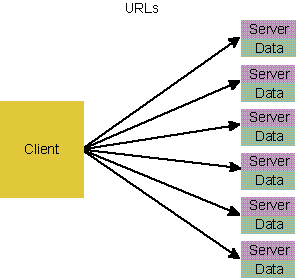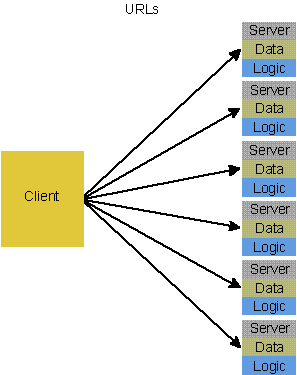
Before jumping in on the thin client application development model, let’s review why everybody is so excited about using the Internet infrastructure for application deployment. The most obvious reason the Internet is so interesting is because it gives users remote access to information. More information is available than will ever fit on a client machine. The question then becomes, which model best enables on-demand, source-independent information browsing?
Figure 1 shows the basic client/server model of the Internet. The client provides the presentation context, typically a browser such as Microsoft Internet Explorer or Netscape Navigator that allows remote data to be viewed through the HTML presentation layer. This data represents a slice of the content of the Internet. The network moves the content to the presentation context via HTTP.

Figure 1 Client/Server Model
URLs further separate the location of content from the presentation context, allowing a browser to access multiple servers and their associated data. Actual access to the content is deferred until the user wants to see it. This deferral mechanism places minimal demands on the network and avoids the transfer of unnecessary data to the client machine. This approach facilitates the exposure of a maximum amount of remote resources with the minimum use of network and client-side resources (see Figure 2).

Figure 2 Remote Data
Remote data isn’t the only reason why the Internet is interesting—users also want to access logic and services not on their local machines. URLs are as useful as locators for remote logic and services as they are for remote data. It’s the combination of data and logic that forms the new content for the Internet. As illustrated in Figure 3, the structure is the same.

Figure 3 Remote Data and Logic
The new content for the Internet is objectsĺspecifically, C++ classes that exist on the server. These are the regular kinds of C++ classes you create, edit, compile, and debug with the Visual C++ development environment. Although the current approach to Internet deployment is typically procedural, where the data operates separately from the logic, it can be enhanced with the object-based model you’re used to.
ActiveX and Java give application deployment more flexibility. The client becomes a mechanism for accessing remote objects on remote servers (see Figure 4). The server contains data and logical content in program structures such as C++ classes.

Figure 4 Remote Object Deployment
How can remote objects best be exposed to the client user over the network infrastructure? The Internet’s greatest potential is realized when logic and services, together with content, are presented to multiple users in a context of transparent, real-time collaboration (see Figure 5). Collaboration in a network environment means that two or more users can communicate with one another by viewing or interacting with common data and services. The sessionless nature of the Internet lets multiple clients access an object’s state concurrently.

Figure 5 Real-time Multiple User Collaboration
Collaboration on the Internet removes the user’s dependency on the location of information and services by allowing many users to interact with information freed from the constraints of monolithic applications. But collaboration in an Internet environment is a particularly difficult task.